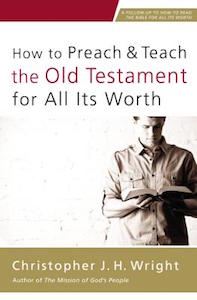Preaching the Bible Jesus Read
Christopher J.H. Wright’s new book helps preachers and teachers see Christ in the Old Testament — and so much more.
The Old Testament is the Bible Jesus Christ read and preached. It is also the Bible of His first followers. When Paul writes, for example, “the Holy Scriptures … are able to make you wise for salvation through faith in Christ Jesus” (2 Timothy 3:15), he has the Old Testament in mind. It is foundational to Christianity.
In too many American churches today, however, the Old Testament goes unread and unpreached. Why read the Old Testament, many seem to reason, when we’ve got the New Testament? Even when read and preached, however, the Old Testament is too often wrenched out of context, reduced to moralistic and legalistic applications, or mined for questionable prophetic significance.
Christopher J.H. Wright sets out to rectify this situation in How to Preach and Teach the Old Testament for All Its Worth. He organizes the book’s material into two sections. The first, comprised of chapters 1-5, asks the question, “Why should we preach and teach from the Old Testament?” The second, comprised of chapters 6-15, asks the question, “How can we preach and teach from the Old Testament?” Wright’s answers to these questions are practical, grounded in sound biblical exegesis and solid evangelical theology, and attuned to both the ancient culture of the biblical writers and the contemporary culture of its readers.
Let me highlight two things that I found helpful as I read Wright’s book:
First, as a Christian minister, I read the Old Testament with confidence that it will help me both to better understand the person and work of Jesus Christ and to better proclaim Him to others. With good reason, I might add! Christ himself says, “these are the very Scriptures that testify about me” (John 5:39). Similarly, Luke describes Christ’s conversations with two disciples on the road to Emmaus this way: “beginning with Moses and all the Prophets, he explained to them what was said in all the Scriptures concerning himself” (Luke 24:27). We’re supposed to find Christ in the Old Testament because He found himself there.
And yet, I’ve heard sermons about Christ from the Old Testament in which the preacher’s intention is good but their biblical interpretation is not. Wright's chapters 3 through 5 help us find Christ in the Old Testament using sound hermeneutical principles.
We’re supposed to find Christ in the Old Testament because He found himself there.
Chapter 3, “Understanding Jesus through the Old Testament,” examines the Old Testament to explain who Jesus thought He was and what He came to do. Chapter 4, “Don’t Just Give Me Jesus,” outlines five “dangers” to avoid when preaching Christ from the Old Testament: (1) ignoring the text’s original meaning; (2) proposing fanciful interpretations; (3) overlooking other things that God teaches in the Old Testament; (4) flattening the biblical story and removing the uniqueness of the Incarnation; and (5) preaching the same message regardless of the text. (To me, this chapter alone was worth the price of the book.) Chapter 5, “Connecting with Christ,” shows how we can preach Christ from the Old Testament in a way that honors its original meaning.
A second thing I found helpful was Wright’s attention to literary genres. He organizes the book’s second section according to the literary genre of the Old Testament: narrative (chapters 6-8); law (chapters 9,10); prophecy (chapters 11,12); psalms (chapters 13,14), and wisdom literature (chapter 15). There are overlaps in these genres, of course. Law (Hebrew torah) includes stories, for example, and prophecy, psalms and proverbs all make use of poetry.
Still, Wright’s discussion shows what’s distinct about these genres, why Christians should pay attention to them, and how attention to them changes the way we interpret and then preach them. (For more on the proper interpretation of the Bible’s literary genres, see Gordon D. Fee and Douglas Stuart’s How to Read the Bible for All Its Worth, the first in a series of books from which Wright’s is the most recent.)
If you preach or teach the Bible at your local church, I encourage you to do two things: First, preach and teach regularly from the Old Testament. Second, read this book. It delivers on its promise of its title and is a helpful guide for seeing Christ in the Old Testament … and so much more!
 Christopher J.H. Wright, How to Preach and Teach the Old Testament for All Its Worth (Grand Rapids, MI: Zondervan, 2016).
Christopher J.H. Wright, How to Preach and Teach the Old Testament for All Its Worth (Grand Rapids, MI: Zondervan, 2016).
Influence Magazine & The Healthy Church Network
© 2025 Assemblies of God

